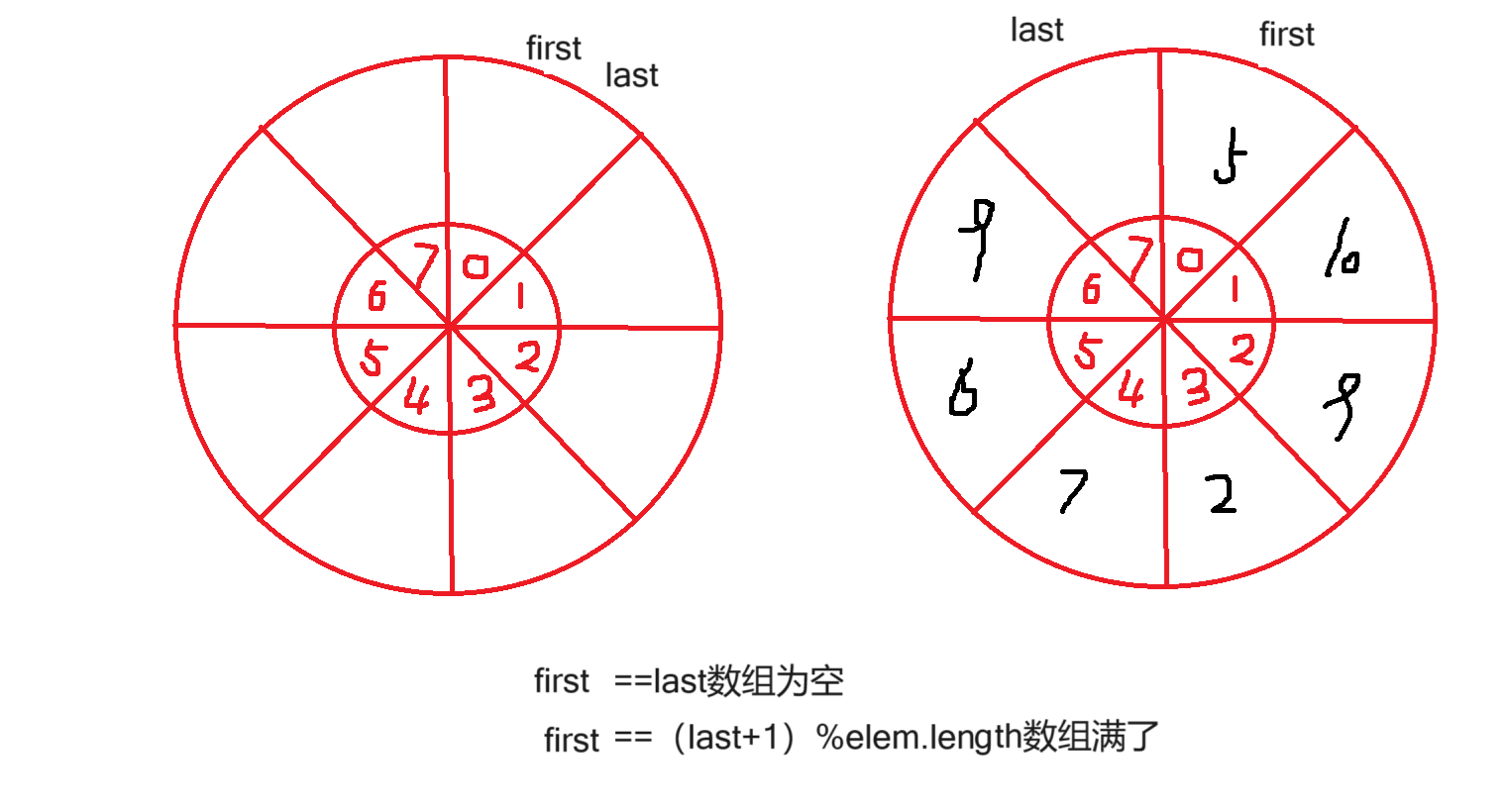队列:只允许在一端进行插入数据操作,在另一端进行删除数据操作的特殊线性表,队列具有先进先出FIFO(First In First Out) 入队列:进行插入操作的一端称为队尾(Tail/Rear) 出队列:进行删除操作的一端称为队头。
自己实现队列:
链表实现:实现一个双向链表,增加元素,采用尾插法,删去元素采用头删法,具体步骤链表处详细讲过,此处不再赘述

public class MyQueue1 {
class ListNode{
public int val;
public ListNode next;
public ListNode prev;
public ListNode(int val) {
this.val = val;
}
}
public ListNode head;
public ListNode last;
public void offer(int val){
ListNode node=new ListNode(val);
if (head==null){
head=last=node;
return;
}
last.next=node;
node.prev=last;
last=node;
}
public boolean isEmpty(){
return head==null;
}
public int poll(){
if (head==null){
throw new NullPointerException();
}
if (head==last){
int tpm=head.val;
head=last=null;
return tpm;
}
int tmp=head.val;
head=head.next;
head.prev=null;
return tmp;
}
public int peek(){
if (head==null){
throw new NullPointerException();
}
int tmp=head.val;
return tmp;
}
}
数组实现循环队列:
1,enQueue:
public boolean enQueue(int val){
if (isFull()){
return false;
}
elem[last]=val;
last=(last+1)%elem.length;
return true;
}
2,deQueue:删除元素时,将first加一,将数组的起始位置改变
public boolean deQueue(){
if (isFull()){
return false;
}
first=(first+1)%elem.length;
return true;
}
3,front:得到队列的首元素
public int front(){
if (isEmpty()){
return -1;
}
return elem[first];
}
4,rear:得到队列的尾元素,注意:last可能等于0(删除一次时).这时last-1=-1,出现越界。所以这种情况应该单独判断
public int rear(){
if (isEmpty()){
return -1;
}
int index=(last==0)?elem.length-1:last-1;
return elem[index];
}
5,isFull/isEmpty:
public boolean isFull(){
return (last+1)%elem.length==first;
}
public boolean isEmpty(){
return last==first;
}
6,因为对数组初始化的时候,初始化数组的容量,但上述解法会浪费一块空间,所以真实的数组容量比初始化的少一个,所以构造方法应该写成如下这种方式:
public MyQueue2(int k) {
this.elem = new int[k+1];
}
两个队列实现一个栈

public class Queue3 {
public Queue<Integer> queue1;
public Queue<Integer> queue2;
public Queue3() {
this.queue1 = new LinkedList<>();
this.queue2 = new LinkedList<>();
}
}
1,poll:如图,在栈中,4会最先从栈顶取出,而队列1中最先取出的是1,所以想要取出4,就要将1,2,3弹出放到队列2中。这时,取出的就是4了。同理可得:想要取出元素,先判断的、那个队列中含有元素,将有元素的队列中的元素放到另一个队列中。
public int poll(){
if (isEmpty()){
return -1;
}
if (!queue1.isEmpty()){
int size=queue1.size();
for (int i = 0; i < size-1; i++) {
queue2.offer(queue1.poll());
}
return queue1.poll();
}else {
int size=queue2.size();
for (int i = 0; i < size-1; i++) {
queue1.offer(queue2.poll());
}
return queue2.poll();
}
}
2,top:得到栈顶元素,与上述处理方法基本一致
public int top(){
if (isEmpty()){
return -1;
}
if (!queue1.isEmpty()){
int size=queue1.size();
for (int i = 0; i < size-1; i++) {
queue2.offer(queue1.poll());
}
int tmp=queue1.peek();
queue2.offer(queue1.poll());
return tmp;
}else {
int size=queue2.size();
for (int i = 0; i < size-1; i++) {
queue1.offer(queue2.poll());
}
int tmp=queue2.peek();
queue1.offer(queue2.poll());
return tmp;
}
}
3,offer:增加元素,先判断那个队列中有元素,将添加的元素放到有元素的队列中
public void offer(int val){
if (isEmpty()){
queue1.offer(val);
return;
}
if (!queue1.isEmpty()){
queue1.offer(val);
}else {
queue2.offer(val);
}
}
4,isEmpty:当两个队列中的均为空时,这说明他们等价的栈中也没元素
public boolean isEmpty(){
return queue1.isEmpty()&&queue2.isEmpty();
}
两个栈实现一个队列

public class Queue4 {
public Stack<Integer> stack1;
public Stack<Integer> stack2;
public Queue4() {
this.stack1 = new Stack<>();
this.stack2 = new Stack<>();
}
}
1,poll:如图,队列中最先取出的是1,而栈1中最先取出的是4,所以要将栈1中的元素全部放到栈2中,然后取出栈2 的栈顶元素就是队列最先取出的元素。
public int poll(){
if (isEmpty()){
return -1;
}
if (stack2.empty()){
while (!stack1.empty()){
stack2.push(stack1.pop());
}
}
return stack2.pop();
}
2,top:取出队头元素,与上述的方法大致相同
public int top(){
if (isEmpty()){
return -1;
}
if (stack2.empty()){
while (!stack1.empty()){
stack2.push(stack1.pop());
}
}
return stack2.peek();
}
3,offer:直接将元素添加到栈1中
public void offer(int val){
stack1.push(val);
}
4,isEmpty:当两个栈中的均为空时,这说明他们等价的队列中也没元素
public boolean isEmpty(){
return stack1.isEmpty()&&stack2.isEmpty();
}





















 1456
1456

 被折叠的 条评论
为什么被折叠?
被折叠的 条评论
为什么被折叠?








